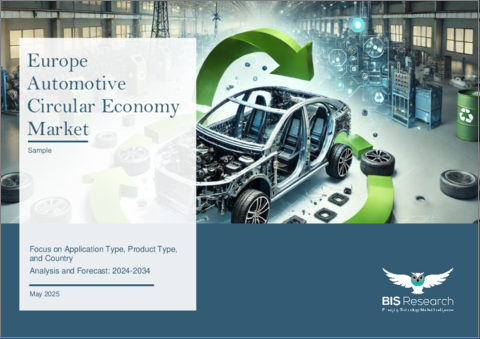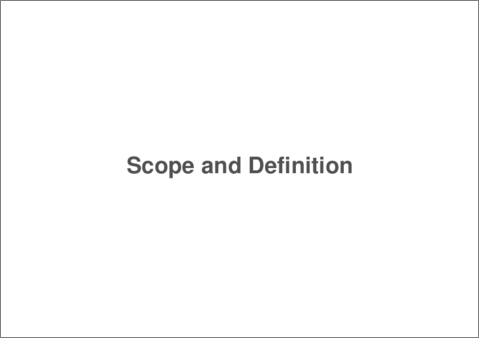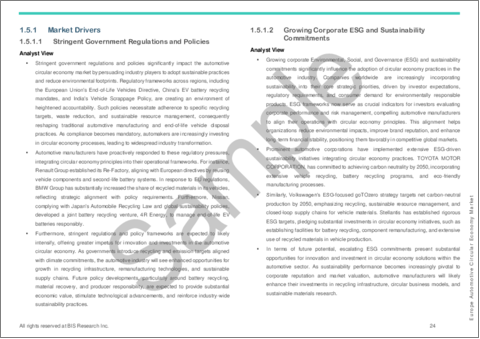|
|
市場調査レポート
商品コード
1735897
欧州の自動車サーキュラーエコノミー市場:用途タイプ別、製品タイプ別、国別 - 分析と予測(2024年~2034年)Europe Automotive Circular Economy Market: Focus on Application Type, Product Type, and Country - Analysis and Forecast, 2024-2034 |
||||||
カスタマイズ可能
|
|||||||
| 欧州の自動車サーキュラーエコノミー市場:用途タイプ別、製品タイプ別、国別 - 分析と予測(2024年~2034年) |
|
出版日: 2025年05月30日
発行: BIS Research
ページ情報: 英文 96 Pages
納期: 1~5営業日
|
全表示
- 概要
- 図表
- 目次
欧州の自動車サーキュラーエコノミーの市場規模は、2024年に304億3,000万米ドルとなりました。
同市場は、12.66%のCAGRで拡大し、2034年には1,002億5,000万米ドルに達すると予測されています。欧州の自動車産業が、リサイクル、再製造、部品や材料の再利用を含むサーキュラーエコノミー(循環型経済)コンセプトへの移行を急速に進めた結果、市場が拡大しています。欧州のメーカーや規制当局がより資源効率の高い持続可能な方法を採用するにつれて、完全にリサイクル可能な、再製造された、再生品の自動車部品のニーズは高まると予想されます。この成長は、二酸化炭素排出量の削減、自動車寿命の延長、生産プロセスの最適化を求める規制圧力の高まりによってさらに後押しされます。欧州大陸の自動車サーキュラーエコノミー市場は、グリーン技術の開発、電気自動車の台頭、欧州連合の野心的なサーキュラーエコノミー行動計画など、多くの要因により、今後10年間で大きく成長すると予想されます。
| 主要市場統計 | |
|---|---|
| 予測期間 | 2024年~2034年 |
| 2024年の評価 | 304億3,000万米ドル |
| 2034年の予測 | 1,002億5,000万米ドル |
| CAGR | 12.66% |
欧州の自動車サーキュラーエコノミー市場は、資源効率、持続可能性、規制遵守が同分野の開発に不可欠となるにつれ、急激な変化を遂げつつあります。欧州の自動車メーカーは、環境への影響とバージン原材料への依存度を低減するよう求める圧力の高まりに対応して、リサイクル、再製造、再利用、自動車部品のライフサイクルの延長を重視するサーキュラーエコノミーの原則を採用しつつあります。
このシフトは、使用済み自動車(ELV)指令やサーキュラーエコノミー行動計画を含む欧州連合の強固な法的枠組みによって大きく形作られています。これらの規制は、エコデザインを刺激し、持続可能な生産方法を支援し、より大きな回収・再利用目標を設定しています。また、エコロジーに配慮した自動車や部品を求める消費者の需要の高まりによって、業界における循環型技術の採用も加速しています。
IoT、デジタルツイン、AIを活用した材料追跡などのデジタル技術の躍進は、循環型サプライチェーンの効率性と透明性を向上させています。さらに、クローズドループリサイクルシステムやセカンドライフバッテリー用途の新たな展望が、電気自動車の成長によってもたらされています。この業界は、高い初期費用、素材の複雑さ、加盟国間で異なる実施基準といった障害にもかかわらず、着実に成長すると予想されます。欧州は、政府の強力な支援、技術革新の能力、官民協力の取り組みにより、自動車サーキュラーエコノミーへの取り組みにおいて世界をリードしています。
欧州の自動車サーキュラーエコノミー市場の動向、促進要因・課題
動向
- クローズドループ製造と再製造ネットワークの拡大
- ライフサイクルモニタリングのためのデジタルトラッキング(IoT、デジタルツイン)の統合
- ビークル・アズ・ア・サービスとサブスクリプション・モデルの成長
- EVバッテリーと部品のセカンドライフ・アプリケーション
- バイオベースおよびリサイクル可能な材料の使用の増加
促進要因
- 厳しいEU規制(サーキュラーエコノミー行動計画、使用済み自動車指令)
- 企業のESGコミットメントと持続可能性目標
- 環境に優しい自動車や部品に対する消費者の需要の高まり
- 材料回収と原材料輸入削減別コスト削減
- リサイクル技術と自動選別の進歩
課題
- 高度なリサイクルおよび再製造施設のための高額な資本支出
- サプライチェーンの複雑さと、加盟国間で一貫性のない基準
- リサイクル原料の市場受容が限定的で価格変動が激しいこと
- 複合材料や複数の材料からなる部品の分離と処理における技術的障壁
- 熟練労働力と専門的なリバース・ロジスティクス・インフラの必要性
製品/イノベーション戦略:欧州の自動車サーキュラーエコノミー市場は、様々な用途、車両タイプ、推進力タイプ、製品カテゴリーに基づいてセグメント化されており、業界の持続可能性へのシフトに関する貴重な洞察を提供しています。用途別では、車体部品、タイヤ、バッテリーなど、リサイクル、再製造、改修、再利用される主要要素に重点を置いています。車両タイプ別では、市場は乗用車と商用車に分けられ、後者は小型商用車、トラック、バスにさらに細分化されます。推進力タイプには内燃機関車と電気自動車があり、電気自動車はハイブリッド電気自動車、プラグインハイブリッド電気自動車、バッテリー電気自動車に細かく分類されます。市場はまた、OEM(相手先ブランド製造)、自動車アフターマーケット、その他を含むエンドユーザー・タイプ別に分析されています。
さらに、リサイクル製品、再製造製品、再生製品、再利用製品などの製品タイプにも焦点を当てています。この循環型経済における主要部品には、バッテリー、タイヤ、ポリマー、ボディ部品、ブレーキ・サスペンションなどがあります。自動車業界が廃棄物の削減と資源効率の向上を目指す中、こうした循環型経済の実践は持続可能性の目標達成に不可欠なものとなりつつあり、市場の成長を牽引しています。
成長/マーケティング戦略:欧州の自動車サーキュラーエコノミー市場は急速なペースで成長しています。同市場は、既存および新興の市場プレーヤーに莫大な機会を提供しています。このセグメントで取り上げる戦略には、M&A、製品投入、提携・協力、事業拡大、投資などがあります。企業が市場での地位を維持・強化するために好む戦略には、主に製品開発が含まれます。
競合戦略:本調査で分析・プロファイリングした欧州自動車サーキュラーエコノミー市場の主要企業プロファイルには、自動車および自動車領域の専門知識を有する専門家が含まれています。さらに、提携、合意、協力などの包括的な競合情勢は、市場の未開拓の収益ポケットを理解する上で読者を支援するものと期待されます。
当レポートでは、欧州の自動車サーキュラーエコノミー市場について調査し、市場の概要とともに、用途タイプ別、製品タイプ別、国別の動向、および市場に参入する企業のプロファイルなどを提供しています。
目次
エグゼクティブサマリー
第1章 市場
- 動向:現状と将来への影響評価
- サプライチェーンの概要
- 規制状況
- 主要な世界的出来事の影響分析
- 市場力学の概要
- 投資情勢
- 自動車循環型経済市場のケーススタディ
- 自動車循環型経済の概要
第2章 地域
- 地域サマリー
- 欧州
- 地域概要
- 市場成長促進要因
- 市場成長抑制要因
- 用途
- 製品
- 欧州(国別)
第3章 市場-競合ベンチマーキングと企業プロファイル
- 今後の見通し
- 地理的評価
- リサイクル会社
- Umicore
- 再製造
- ZF Friedrichshafen AG
- Valeo
- 統合サーキュラーエコノミーソリューション
- Renault Group
- BMW Group
- テクノロジープロバイダー
- Aptiv
- 部品サプライヤー
- Bosch GmbH
第4章 調査手法
List of Figures
- Figure 1: Europe Automotive Circular Economy Market (by Scenario), $Million, 2024, 2028, and 2034
- Figure 2: Automotive Circular Economy Market (by Region), $Million, 2023, 2027, and 2034
- Figure 3: Europe Automotive Circular Economy Market (by Vehicle Type), $Million, 2023, 2027, and 2034
- Figure 4: Europe Automotive Circular Economy Market (by Propulsion Type), $Million, 2023, 2027, and 2034
- Figure 5: Europe Automotive Circular Economy Market (by End-User Type), $Million, 2023, 2027, and 2034
- Figure 6: Europe Automotive Circular Economy Market (by Process Type), $Million, 2023, 2027, and 2034
- Figure 7: Europe Automotive Circular Economy Market (by Component Type), $Million, 2023, 2027, and 2034
- Figure 8: Key Events
- Figure 9: Projected Battery Recycling Capacity (by Region), 2023-2030
- Figure 10: Supply Chain
- Figure 11: Impact Analysis of Market Navigating Factors, 2023-2034
- Figure 12: Renault Group's Flins Refactory
- Figure 13: Michelin and Enviro (MSMR Chile)
- Figure 14: LyondellBasell and Audi AG (Germany-Automaker)
- Figure 15: U.K. Automotive Circular Economy Market, $Million, 2023-2034
- Figure 16: Germany Automotive Circular Economy Market, $Million, 2023-2034
- Figure 17: Italy Automotive Circular Economy Market, $Million, 2023-2034
- Figure 18: France Automotive Circular Economy Market, $Million, 2023-2034
- Figure 19: Spain Automotive Circular Economy Market, $Million, 2023-2034
- Figure 20: Netherlands Automotive Circular Economy Market, $Million, 2023-2034
- Figure 21: Rest-of-Europe Automotive Circular Economy Market, $Million, 2023-2034
- Figure 22: Strategic Initiatives, January 2022-March 2025
- Figure 23: Share of Strategic Initiatives, 2023
- Figure 24: Data Triangulation
- Figure 25: Top-Down and Bottom-Up Approach
- Figure 26: Assumptions and Limitations
List of Tables
- Table 1: Market Snapshot
- Table 2: Opportunities across Region
- Table 3: Competitive Landscape Snapshot
- Table 4: Trends Overview
- Table 5: Regulations for Automotive Circular Economy
- Table 6: Investment Landscape in the Automotive Circular Economy Market
- Table 7: Sustainability and ESG Goals of Key Automotive Companies
- Table 8: Automotive Circular Economy Market (by Region), $Million, 2023-2034
- Table 9: Europe Automotive Circular Economy Market (by Vehicle Type), $Million, 2023-2034
- Table 10: Europe Automotive Circular Economy Market (by Propulsion Type), $Million, 2023-2034
- Table 11: Europe Automotive Circular Economy Market (by End-User Type), $Million, 2023-2034
- Table 12: Europe Automotive Circular Economy Market (by Process Type), $Million, 2023-2034
- Table 13: Europe Automotive Circular Economy Market (by Component Type), $Million, 2023-2034
- Table 14: U.K. Automotive Circular Economy Market (by Vehicle Type), $Million, 2023-2034
- Table 15: U.K. Automotive Circular Economy Market (by Propulsion Type), $Million, 2023-2034
- Table 16: U.K. Automotive Circular Economy Market (by End-User Type), $Million, 2023-2034
- Table 17: U.K. Automotive Circular Economy Market (by Process Type), $Million, 2023-2034
- Table 18: U.K. Automotive Circular Economy Market (by Component Type), $Million, 2023-2034
- Table 19: Germany Automotive Circular Economy Market (by Vehicle Type), $Million, 2023-2034
- Table 20: Germany Automotive Circular Economy Market (by Propulsion Type), $Million, 2023-2034
- Table 21: Germany Automotive Circular Economy Market (by End-User Type), $Million, 2023-2034
- Table 22: Germany Automotive Circular Economy Market (by Process Type), $Million, 2023-2034
- Table 23: Germany Automotive Circular Economy Market (by Component Type), $Million, 2023-2034
- Table 24: Italy Automotive Circular Economy Market (by Vehicle Type), $Million, 2023-2034
- Table 25: Italy Automotive Circular Economy Market (by Propulsion Type), $Million, 2023-2034
- Table 26: Italy Automotive Circular Economy Market (by End-User Type), $Million, 2023-2034
- Table 27: Italy Automotive Circular Economy Market (by Process Type), $Million, 2023-2034
- Table 28: Italy Automotive Circular Economy Market (by Component Type), $Million, 2023-2034
- Table 29: France Automotive Circular Economy Market (by Vehicle Type), $Million, 2023-2034
- Table 30: France Automotive Circular Economy Market (by Propulsion Type), $Million, 2023-2034
- Table 31: France Automotive Circular Economy Market (by End-User Type), $Million, 2023-2034
- Table 32: France Automotive Circular Economy Market (by Process Type), $Million, 2023-2034
- Table 33: France Automotive Circular Economy Market (by Component Type), $Million, 2023-2034
- Table 34: Spain Automotive Circular Economy Market (by Vehicle Type), $Million, 2023-2034
- Table 35: Spain Automotive Circular Economy Market (by Propulsion Type), $Million, 2023-2034
- Table 36: Spain Automotive Circular Economy Market (by End-User Type), $Million, 2023-2034
- Table 37: Spain Automotive Circular Economy Market (by Process Type), $Million, 2023-2034
- Table 38: Spain Automotive Circular Economy Market (by Component Type), $Million, 2023-2034
- Table 39: Netherlands Automotive Circular Economy Market (by Vehicle Type), $Million, 2023-2034
- Table 40: Netherlands Automotive Circular Economy Market (by Propulsion Type), $Million, 2023-2034
- Table 41: Netherlands Automotive Circular Economy Market (by End-User Type), $Million, 2023-2034
- Table 42: Netherlands Automotive Circular Economy Market (by Process Type), $Million, 2023-2034
- Table 43: Netherlands Automotive Circular Economy Market (by Component Type), $Million, 2023-2034
- Table 44: Rest-of-Europe Automotive Circular Economy Market (by Vehicle Type), $Million, 2023-2034
- Table 45: Rest-of-Europe Automotive Circular Economy Market (by Propulsion Type), $Million, 2023-2034
- Table 46: Rest-of-Europe Automotive Circular Economy Market (by End-User Type), $Million, 2023-2034
- Table 47: Rest-of-Europe Automotive Circular Economy Market (by Process Type), $Million, 2023-2034
- Table 48: Rest-of-Europe Automotive Circular Economy Market (by Component Type), $Million, 2023-2034
- Table 49: Market Share
- Table 50: Developments (by Company)
Introduction to Europe Automotive Circular Economy Market
The Europe automotive circular economy market was valued at $30.43 billion in 2024 and is projected to grow at a CAGR of 12.66%, reaching $100.25 billion by 2034. The market is expanding as a result of Europe's automotive industry's rapid transition to circular economy concepts, which include recycling, remanufacturing, and reusing components and materials. The need for fully recyclable, remanufactured, and refurbished car components is expected to increase as European manufacturers and regulators adopt more resource-efficient and sustainable methods. This growth is further supported by increased regulatory pressure to reduce carbon emissions, prolong vehicle lifespans, and optimise production processes. The automotive circular economy market on the continent is expected to grow significantly over the next ten years due to a number of factors, including the development of green technology, the rise in electric vehicles, and the European Union's ambitious circular economy action plan.
Market Introduction
| KEY MARKET STATISTICS | |
|---|---|
| Forecast Period | 2024 - 2034 |
| 2024 Evaluation | $30.43 Billion |
| 2034 Forecast | $100.25 Billion |
| CAGR | 12.66% |
The automobile circular economy market in Europe is undergoing a radical change as resource efficiency, sustainability, and regulatory compliance become crucial to the development of the sector. Automotive manufacturers around Europe are adopting the circular economy principles-which emphasise recycling, remanufacturing, reusing, and prolonging the life cycle of vehicle components-in response to growing pressure to lessen their impact on the environment and their dependency on virgin raw materials.
This shift is being significantly shaped by the robust legislative framework of the European Union, which includes the End-of-Life Vehicle (ELV) Directive and the Circular Economy Action Plan. These regulations stimulate eco-design, support sustainable production practices, and set greater recovery and reuse goals. Industry adoption of circular techniques is also being accelerated by rising consumer demand for ecologically friendly automobiles and parts.
Digital technology breakthroughs like IoT, digital twins, and AI-powered material tracking are improving the circular supply chain's efficiency and transparency. Furthermore, new prospects for closed-loop recycling systems and second-life battery applications have been brought about by the growth of electric vehicles. The industry is expected to grow steadily in spite of obstacles such high upfront costs, material complexity, and disparate member state implementation norms. Europe is a global leader in automotive circular economy initiatives because of its robust governmental support, capacity for innovation, and cooperative public-private efforts.
Market Segmentation:
Segmentation 1: by Vehicle Type
- Passenger Vehicles
- Commercial Vehicles
- Light Commercial Vehicles
- Trucks
- Buses
Segmentation 2: by Propulsion Type
- Internal Combustion Engine Vehicles
- Electric Vehicles
- Hybrid Electric Vehicles
- Plug-In Hybrid Electric Vehicles
- Battery Electric Vehicles
Segmentation 3: by End-User Type
- Original Equipment Manufacturers (OEMs)
- Automotive Aftermarket
- Others
Segmentation 4: by Process Type
- Recycled Products
- Remanufactured Products
- Refurbished Products
- Reused Products
Segmentation 5: by Component Type
- Battery
- Tire
- Polymers
- Body Parts
- Brakes and Suspensions
- Others
Segmentation 6: by Region
- Europe: U.K., Germany, Italy, France, Spain, Netherlands, and Rest-of-Europe
Europe Automotive Circular Economy Market Trends, Drivers and Challenges-
Trends
- Expansion of closed-loop manufacturing and remanufacturing networks
- Integration of digital tracking (IoT, digital twins) for lifecycle monitoring
- Growth of vehicle-as-a-service and subscription models
- Second-life applications for EV batteries and parts
- Increased use of bio-based and recyclable materials
Drivers
- Stringent EU regulations (Circular Economy Action Plan, End-of-Life Vehicle Directive)
- Corporate ESG commitments and sustainability targets
- Rising consumer demand for eco-friendly vehicles and components
- Cost savings from material recovery and reduced raw-material imports
- Advances in recycling technologies and automated sorting
Challenges
- High capital expenditure for advanced recycling and remanufacturing facilities
- Supply-chain complexity and inconsistent standards across member states
- Limited market acceptance and pricing volatility for recycled materials
- Technical barriers in separating and processing composite and multi-material parts
- Need for skilled workforce and specialized reverse-logistics infrastructure
How can this report add value to an organization?
Product/Innovation Strategy: The Europe automotive circular economy market is segmented based on various applications, vehicle types, propulsion types, and product categories, providing valuable insights into the industry's shift toward sustainability. The application segmentation includes a focus on vehicle components such as body parts, tires, batteries, and other key elements that are recycled, remanufactured, refurbished, and reused. By vehicle type, the market is divided into passenger vehicles and commercial vehicles, with the latter further segmented into light commercial vehicles, trucks, and buses. Propulsion types include internal combustion engine vehicles and electric vehicles, which are sub-categorized into hybrid electric vehicles, plug-in hybrid electric vehicles, and battery electric vehicles. The market is also analyzed by end-user type, including original equipment manufacturers (OEMs), the automotive aftermarket, and others.
Additionally, the market focuses on product types such as recycled, remanufactured, refurbished, and reused products. Key components in this circular economy include batteries, tires, polymers, body parts, and brakes and suspensions. As the automotive industry seeks to reduce waste and improve resource efficiency, these circular economy practices are becoming integral to achieving sustainability goals and driving growth in the market.
Growth/Marketing Strategy: The Europe automotive circular economy market has been growing at a rapid pace. The market offers enormous opportunities for existing and emerging market players. Some of the strategies covered in this segment are mergers and acquisitions, product launches, partnerships and collaborations, business expansions, and investments. The strategies preferred by companies to maintain and strengthen their market position primarily include product development.
Competitive Strategy: The key players in the Europe automotive circular economy market analyzed and profiled in the study include professionals with expertise in the automobile and automotive domains. Additionally, a comprehensive competitive landscape such as partnerships, agreements, and collaborations are expected to aid the reader in understanding the untapped revenue pockets in the market.
Key Market Players and Competition Synopsis
The companies that are profiled in the Europe automotive circular economy market have been selected based on inputs gathered from primary experts who have analyzed company coverage, product portfolio, and market penetration.
Some of the prominent names in this market are:
- Umicore
- ZF Friedrichshafen AG
- Valeo
- Renault Group
- BMW Group
- Aptiv.
- Bosch GmbH
Table of Contents
Executive Summary
Scope and Definition
1 Markets
- 1.1 Trends: Current and Future Impact Assessment
- 1.1.1 Increasing Focus on Battery Recycling and Second Life Applications
- 1.1.2 Growth of Vehicle Remanufacturing
- 1.2 Supply Chain Overview
- 1.3 Regulatory Landscape
- 1.4 Impact Analysis for Key Global Events
- 1.4.1 Implementation of Stringent Environmental Regulations
- 1.4.2 Global Climate Agreements and ESG Initiatives
- 1.5 Market Dynamics Overview
- 1.5.1 Market Drivers
- 1.5.1.1 Stringent Government Regulations and Policies
- 1.5.1.2 Growing Corporate ESG and Sustainability Commitments
- 1.5.2 Market Restraints
- 1.5.2.1 Complex Supply Chains and Infrastructure Challenges
- 1.5.2.2 Inconsistent Global Regulations
- 1.5.3 Market Opportunities
- 1.5.3.1 Growing EV adoption Creating Substantial Opportunities in Repurposing Batteries
- 1.5.3.2 Expansion of Circular Supply Chains and Partnerships
- 1.5.1 Market Drivers
- 1.6 Investment Landscape
- 1.7 Automotive Circular Economy Market Case Studies
- 1.8 Automotive Circular Economy Overview
- 1.8.1 Need for Circular Economy in the Automotive Industry
- 1.8.2 Sustainability and ESG Goals of Key Automotive Companies
- 1.8.3 Impact of Circular Economy on Various Automotive Lifecycle Stages
- 1.8.3.1 Manufacturing
- 1.8.3.2 Retail
- 1.8.3.3 Aftermarket
- 1.8.4 Impact of Automotive Circular Economy
- 1.8.4.1 Recycled Materials
- 1.8.4.2 Green Steel
- 1.8.4.3 Climate Neutral Vehicles
- 1.8.4.4 Sustainable Manufacturing Plants
- 1.8.4.5 Green Dealerships
- 1.8.4.6 Second-Life Batteries
2 Regions
- 2.1 Regional Summary
- 2.2 Europe
- 2.2.1 Regional Overview
- 2.2.2 Driving Factors for Market Growth
- 2.2.3 Factors Challenging the Market
- 2.2.4 Application
- 2.2.5 Product
- 2.2.6 Europe (by Country)
- 2.2.6.1 U.K.
- 2.2.6.1.1 Application
- 2.2.6.1.2 Product
- 2.2.6.2 Germany
- 2.2.6.2.1 Application
- 2.2.6.2.2 Product
- 2.2.6.3 Italy
- 2.2.6.3.1 Application
- 2.2.6.3.2 Product
- 2.2.6.4 France
- 2.2.6.4.1 Application
- 2.2.6.4.2 Product
- 2.2.6.5 Spain
- 2.2.6.5.1 Application
- 2.2.6.5.2 Product
- 2.2.6.6 Netherlands
- 2.2.6.6.1 Application
- 2.2.6.6.2 Product
- 2.2.6.7 Rest-of-Europe
- 2.2.6.7.1 Application
- 2.2.6.7.2 Product
- 2.2.6.1 U.K.
3 Markets - Competitive Benchmarking and Company Profiles
- 3.1 Next Frontiers
- 3.2 Geographic Assessment
- 3.3 Recycling Companies
- 3.3.1 Umicore
- 3.3.1.1 Overview
- 3.3.1.2 Top Products/Product Portfolio
- 3.3.1.3 Top Competitors
- 3.3.1.4 Target Customers/End Users
- 3.3.1.5 Key Personnel
- 3.3.1.6 Analyst View
- 3.3.1.7 Market Share, 2023
- 3.3.1 Umicore
- 3.4 Remanufacturing
- 3.4.1 ZF Friedrichshafen AG
- 3.4.1.1 Overview
- 3.4.1.2 Top Products/Product Portfolio
- 3.4.1.3 Top Competitors
- 3.4.1.4 Target Customers/End Users
- 3.4.1.5 Key Personnel
- 3.4.1.6 Analyst View
- 3.4.1.7 Market Share, 2023
- 3.4.2 Valeo
- 3.4.2.1 Overview
- 3.4.2.2 Top Products/Product Portfolio
- 3.4.2.3 Top Competitors
- 3.4.2.4 Target Customers/End Users
- 3.4.2.5 Key Personnel
- 3.4.2.6 Analyst View
- 3.4.2.7 Market Share, 2023
- 3.4.1 ZF Friedrichshafen AG
- 3.5 Integrated Circular Economy Solutions
- 3.5.1 Renault Group
- 3.5.1.1 Overview
- 3.5.1.2 Top Products/Product Portfolio
- 3.5.1.3 Top Competitors
- 3.5.1.4 Target Customers/End Users
- 3.5.1.5 Key Personnel
- 3.5.1.6 Analyst View
- 3.5.1.7 Market Share, 2023
- 3.5.2 BMW Group
- 3.5.2.1 Overview
- 3.5.2.2 Top Products/Product Portfolio
- 3.5.2.3 Top Competitors
- 3.5.2.4 Target Customers/End Users
- 3.5.2.5 Key Personnel
- 3.5.2.6 Analyst View
- 3.5.2.7 Market Share, 2023
- 3.5.1 Renault Group
- 3.6 Technology Providers
- 3.6.1 Aptiv.
- 3.6.1.1 Overview
- 3.6.1.2 Top Products/Product Portfolio
- 3.6.1.3 Top Competitors
- 3.6.1.4 Target Customers/End Users
- 3.6.1.5 Key Personnel
- 3.6.1.6 Analyst View
- 3.6.1.7 Market Share, 2023
- 3.6.1 Aptiv.
- 3.7 Parts and Components Suppliers
- 3.7.1 Bosch GmbH
- 3.7.1.1 Overview
- 3.7.1.2 Top Products/Product Portfolio
- 3.7.1.3 Top Competitors
- 3.7.1.4 Target Customers/End Users
- 3.7.1.5 Key Personnel
- 3.7.1.6 Analyst View
- 3.7.1.7 Market Share, 2023
- 3.7.1 Bosch GmbH
4 Research Methodology
- 4.1 Data Sources
- 4.1.1 Primary Data Sources
- 4.1.2 Secondary Data Sources
- 4.1.3 Data Triangulation
- 4.2 Market Estimation and Forecast





